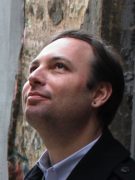Durling Avenue
Summer in its simplest colors
comes over Durling Avenue.
The sweetest invitations come
understated, the girl in the yard
barely lifts her eyebrows, the boy
shrugs his shoulders as if to say
I’ve been waiting, I can wait.
All we’re asked to do is recognize
the beckoning—the grass
splashed brown that will be cut
by dusk, the woman who’s placed
sun tea on her porch. She wears
the dress her mother wore,
lets it fall about her hips and pauses
because it’s Saturday, nothing
pressing in the news, the radio
turned to Frankie Avalon
and laughter, those days, that
handful of Pontiacs moving slowly,
making no dust. There are streets
in America that defend themselves
against time, streets of blackberry
and elm and clusters of boys
lining up to play stickball. I stop
the car and listen to their rules:
the phone pole’s foul, the hedge
behind the Murray house always
an inside-the-park home run.
If rain comes, the great, mournful
interruptor, we take lunch
to the pavilion at Memorial Park
and wait. Maybe Susie St. Claire
in her dress will bring sun tea;
maybe we can save the freckles
on her shoulders for later,
for bed, when all is cricket-sound,
the Erie train, our fathers holding
our church shoes under lamplight.
I was of and not of them,
inside their clothes and distant,
driving toward Broad Street
where the new light flickered red
(it was 1962, it was today)
at the Lutheran church, where I
married the day summer ended.
All the trees were yellow and I
in my gray suit lingered, laughed,
in time and far beyond it.





